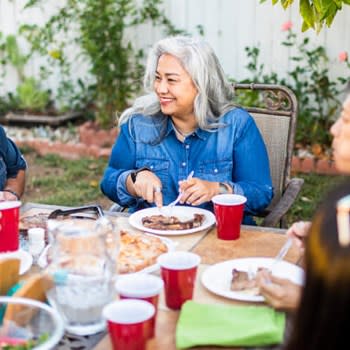Rates of Depression in LGBTQ Communities, by State
Our analysis of U.S. Census Bureau data shows nearly two out of three people who identify as LGBTQ experienced some degree of depression in January. Learn about the states where LGBTQ residents are suffering at a higher rate, and where they are reporting no depression at all.

- Nearly two out of three people who identify as LGBTQ experience feelings of depression to some degree, a rate that is 21% higher than those who do not identify as LGBTQ.
- The highest rates of depression among LGBTQ residents were reported in South Dakota (87%), Vermont (84%) and Montana (77%).
- Nationally, more than one in five of those who identify as LGBTQ experience feelings of depression “nearly every day.”
Nearly two out of every three Americans who identify as LGBTQ suffer from at least some degree of depression. People who identify as LGBTQ report considerably higher rates of depression than those who do not identify as LGBTQ.
These findings are based on our analysis of data from the U.S. Census Bureau’s Household Pulse Survey. We uncovered which states have the highest rates of depression among the LGBTQ community in January, as well as the states whose LGBTQ residents reported no depression “at all” in the past few weeks.
These findings support previous studies that demonstrated LGBTQ adults are more likely than others to experience substance abuse or mental health problems, and 40% of transgender adults have attempted suicide (compared to less than 5% of the general population in America).
Learn more about LGBTQ mental health in your state, and explore a list of resources designed to help you or a loved one facing depression.
Nationwide, nearly 63% of people who identify as LGBTQ report feeling “down, depressed or hopeless” at least once per week.
Some experience these feelings of depression more than half the days or nearly every day. That’s 11 percentage points higher than the 52% rate of depression among Americans who do not identify as LGBTQ.
Click on image to enlarge in a new tab
More than 87% of LGBTQ residents in South Dakota report feelings of depression at least one day per week, which was the highest in the nation and 38% higher than the national average. Vermont was close behind at a rate of 84%.
All told, at least two out of three LGBTQ residents in 23 states experienced feelings of depression at least once a week in January.
Nationwide, 20.9% of those who identify as LGBTQ report feelings of depression “nearly every day.” That rate is much higher than the 7.9% of people who identify as non-LGBTQ and report nearly daily feelings of depression.
The table below highlights the 10 states where the highest rate of LGBTQ residents report this severe level of depression.
Click on image to enlarge in a new tab
In South Dakota, 49% experience feelings of depression nearly every day, or well over half of all those in the state’s LGBTQ community who experience depression. That’s 41% more than the next state (Connecticut).
Over a quarter of LGBTQ Americans (26.5%) reported experiencing depression “not at all” during the study period. Nearly half (48.1%) of Americans who identify as non-LGBTQ reported the same lack of depression during the study period.
The table below highlights the 10 states where the highest rate of LGBTQ residents report experiencing no depression at all.
Click on image to enlarge in a new tab
LGBTQ residents of Louisiana and Illinois reported the highest rates of no depression "at all." Maine, California and Wyoming rounded out the top five states in this category.
Depression rates among Americans who identify as LGBTQ are considerably higher than those who do not identify as LGBTQ.
While 62.7% of those who identify as LGBTQ report experiencing at least some degree of depression, only 40.4% of those who identify as non-LGBTQ report the same.
As mentioned above, nearly half of those who identify as non-LGBTQ (48.1%) reported no feelings of depression during the study period, compared to only 32% of those who do identify as LGBTQ. Among those who reported feeling depressed nearly every day, the disparity was 21% (LGBTQ) to 8% (non-LGBTQ).
Nearly 40% of Americans who identify as transgender reported experiencing symptoms of depression “nearly every day” or “more than half the days” in January.
Click on image to enlarge in a new tab
While our study does not intend to identify the causes of state variance in reported depression among LGBTQ residents, some of the factors that may or may not contribute to the observed differences in depression rates could include the following.
Legal Protections From Discrimination
Among the 10 states with the highest rates of depression among LGBTQ residents, seven do not have “explicit statewide laws at all protecting people from discrimination on the basis of sexual orientation or gender identity in employment, housing and public accommodations.”
Among the 10 states with the lowest rates of LGBTQ depression, five do in fact have non-discrimination laws that specifically include sexual orientation or gender identity.
Hate Crime Laws
Five of the 10 states with the highest rates of LGBTQ depression do not have hate crime laws that specifically address sexual orientation or gender identity.
Seven of the 10 states with the lowest rates of LGBTQ depression do have these types of hate crime laws that specifically address sexual orientation or gender identity.
LGBTQ Population Density
Eight of the 10 states with the highest rates of LGBTQ depression have an LGBTQ population density that is lower than the national average of 4.5%.
Among the 10 states with the lowest levels of LGBTQ depression, six have LGBTQ population density rates that are higher than the national average.
Overall State Depression Rate
Do states with a high depression rate reported by LGBTQ residents also have a higher overall depression rate among all adults?
Among the 10 states with the highest rates of depression among LGBTQ residents, only three have an overall depression rate that is higher than the national average of 54.6% according to the Census Bureau data.
Among the 10 states with the lowest rates of depression among LGBTQ residents, three states have an overall depression rate that is higher than the national average.
Depression Variance Across Cities
Rates of depression among those who identify as LGBTQ may be isolated within certain areas of a given state. For instance, LGBTQ residents of Texas report a depression rate of 64%, but LGBTQ residents of Dallas report a depression rate of 10 percentage points higher at 74%.
Likewise, LGBTQ residents of Houston report a depression rate of 62.5%, or slightly less than the state average.
Among the 10 most populated cities in the U.S., six states have a depression rate among LGBTQ residents that is higher than their respective state rate. This was true for each of the four most populated cities in the U.S.
Same-Sex Marriage Prohibitions
In 2015, the U.S. Supreme Court ruled it unconstitutional for states to ban same-sex marriages in the landmark civil rights case of Obergefell v. Hodges.
13 states continue to have constitutional bans on same-sex marriage known as “Defense of Marriage” acts, which define marriage as a union between one man and one woman. Because of the federal Obergefell ruling, however, these state bans are not enforceable. Some states have other statutory bans on same-sex marriage, which appear in state family law and are also overruled by the Supreme Court ruling.
Five of the 13 states with (unenforceable) constitutional bans on same-sex marriage also ranked inside the top 10 for depression rates among members of the LGBTQ community. Just one state with a constitutional same-sex marriage ban ranked in the bottom 10 for LGBTQ depression rates (Louisiana).
Politics
Among the 10 states with the highest rates of depression among LGBTQ residents, seven voted Republican in the 2020 presidential election.
Among the 10 states with the lowest reported rates of depression among LGBTQ residents, six voted Democratic in the 2020 presidential election.
Those who identify as LGBTQ experience higher rates of depression than those who identify as non-LGBTQ and the total population overall.
Those who identify as LGBTQ also experience greater frequency of depression than those who do not identify as LGBTQ, and they are more likely to suffer from feelings of depression nearly every day, more than half the days or several days during the January study period.
The data used for this report came from the U.S. Census Bureau’s Household Pulse Survey, specifically Week 41 (Dec. 29, 2021 – Jan. 10, 2022), the most recent data available.
The data includes respondents who answered "yes" or "no" to the demographic question of identifying as Lesbian, Gay, Bisexual or Transgender. For the pie chart on depression rates among transgender Americans, the percentages shown include respondents who specifically identified themselves as transgender.
The percentages in the table titled "LGBTQ Residents Reporting Depression in the Last 2 Weeks" do not add up to 100% for each state, as some survey respondents did not respond to the question about depression symptoms.
Below is a list of resources dedicated to providing counseling and support for people facing depression and other mental health issues.
LGBTQ+ Youth
Free and confidential peer support for the PGBTQ and questioning community ages 25 and younger.
Phone: (800) 246-7743
Visit website
LGBT National Hotline
Anonymous and confidential support for issues related to coming out, gender or sexuality identities, relationship concerns, bullying and more.
Phone: (888) 843-4564
Visit website
Pride Counseling
Online therapy for members of the LGBTQ+ communities, with specialized counselors in depression, stress, anxiety, self-esteem and more.
Visit website
PFLAG
Confidential peer support, education and advocacy for LGBTQ+ people, their parents and families, with chapters in all 50 states.
Phone: (202) 467-8180
Visit website
Q Chat Space
Live online discussion groups for LGBTQ+ teens ages 13 to 19, facilitated by staff experienced with working in LGBTQ+ youth centers.
Phone: (954) 765-6024
Visit website
CenterLink LGBT Community Centers
Connecting people to LGBTQ community centers that address the social, cultural, health and political advocacy needs of LGBTQ community members.
Visit website
LGBT National Youth Talkline
Trained peer counselors offering advice and information for teens on topics such as coming out, sexual health, mental health and more.
Phone: 1 (800) 246-7743
Visit website
SAGE LGBT Elder Hotline
Connects LGBT older people with friendly responders offering confidential support and crisis response. Available to both LGBT elders and their caretakers.
Phone: 1 (877) 360-5428
Visit website
The Trevor Project
The world’s largest suicide prevention and crisis intervention organization for LGBTQ young people.
Phone: (212) 695-8650
Visit website
National Suicide Prevention Lifeline
24/7 free and confidential support for people in distress, as well as prevention and crisis resources and best practices for professionals.
Phone: 1 (800) 273-8255
Visit website
National Institute on Mental Health
The National Institute of Mental Health (NIMH) is the largest scientific organization in the world dedicated to research focused on the understanding, treatment and prevention of mental disorders and the promotion of mental health.
Phone: (866) 615-6464
Visit website
National Alliance on Mental Health
Resources on a wide range of health topics selected from approximately 1,400 government and non-profit organizations to bring you the best, most reliable health information on the Internet.
Phone: (800) 950-NAMI
Visit website
MentalHealth.gov
MentalHealth.gov provides one-stop access to U.S. government mental health and mental health problems information.
Phone: (877) 696-6775
Visit website
BetterHelp
BetterHelp.com helps make professional counseling accessible, affordable, convenient so anyone who struggles with life’s challenges can get help, anytime, anywhere.
Phone: (888) 688-9296
Visit website
TransLifeline.org
Trans Lifeline is a grassroots hotline and microgrants 501(c)(3) non-profit organization offering direct emotional and financial support to trans people in crisis – for the trans community, by the trans community.
Phone: (877) 565-8860
Visit website
ULifeLine
ULifeline is an anonymous, confidential, online resource center, where college students can be comfortable searching for the information they need and want regarding emotional health.
Phone: (800) 273-8255
Visit website






